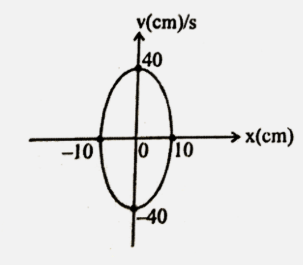The maximum velocity of a particle executing simple harmonic motion is v. If the amplitude is doubled and the time period of oscillation decreased to 1/3 of its original value the maximum velocity becomes
18v
12v
6v
3v
The correct Answer is:C
To solve the problem, we need to find the new maximum velocity of a particle executing simple harmonic motion (SHM) when the amplitude is doubled and the time period is decreased to one-third of its original value.
1. Understanding Maximum Velocity in SHM:
The maximum velocity v of a particle in SHM is given by the formula:
v=Aω
where A is the amplitude and ω is the angular frequency.
2. Relating Angular Frequency to Time Period:
The angular frequency ω is related to the time period T by the formula:
ω=2πT
Therefore, we can rewrite the maximum velocity as:
v=A(2πT)=2πAT
3. Identifying Changes in Amplitude and Time Period:
According to the problem:
- The amplitude is doubled: A′=2A
- The time period is decreased to one-third: T′=T3
4. Calculating New Angular Frequency:
The new angular frequency ω′ can be calculated using the new time period:
ω′=2πT′=2πT3=6πT
5. Calculating New Maximum Velocity:
Now, we can find the new maximum velocity v′:
v′=A′ω′=(2A)(6πT)=12πAT
6. Relating New Maximum Velocity to Original Maximum Velocity:
We know that the original maximum velocity v=2πAT. Thus, we can express v′ in terms of v:
v′=6(2πAT)=6v
Conclusion:
The new maximum velocity v′ becomes 6v.
The maximum velocity v of a particle in SHM is given by the formula:
v=Aω
where A is the amplitude and ω is the angular frequency.
The angular frequency ω is related to the time period T by the formula:
ω=2πT
Therefore, we can rewrite the maximum velocity as:
v=A(2πT)=2πAT
According to the problem:
- The amplitude is doubled: A′=2A
- The time period is decreased to one-third: T′=T3
The new angular frequency ω′ can be calculated using the new time period:
ω′=2πT′=2πT3=6πT
Now, we can find the new maximum velocity v′:
v′=A′ω′=(2A)(6πT)=12πAT
We know that the original maximum velocity v=2πAT. Thus, we can express v′ in terms of v:
v′=6(2πAT)=6v
The new maximum velocity v′ becomes 6v.
Topper's Solved these Questions
Similar Questions
Knowledge Check
The displacement of a particle executing simple harmonic motion is given by y=4sin(2t+ϕ). The period of oscillation is
A2/πBπ/2CπD2πA particle is executing simple harmonic motion. Its total energy is proportional to its
Adisplacement from equilibrium positionBfrequency of oscillationCsquare of amplitude of motionDvelocity at equilibrium positionA particle executing simple harmonic motion with time period T. the time period with which its kinetic energy oscillates is
ATB2TC4TDT2
If particle is excuting simple harmonic motion with time period T, then the time period of its total mechanical energy is :-
View SolutionThe plot of velocity (v) versus displacement (x) of a particle executing simple harmonic motion is shown in figure. The time period of oscillation of particle is :-

View SolutionThe maximum velocity of a particle, executing SHM with an amplitude 7 mm is 4.4 m/s. the period of oscillation is
View SolutionMaximum speed of a particle in simple harmonic motion is vmax. Then average speed of this particle in one time period is equal to
View SolutionA particle executing simple harmonic motion with an amplitude A. The distance travelled by the particle in one time period is
View Solution
